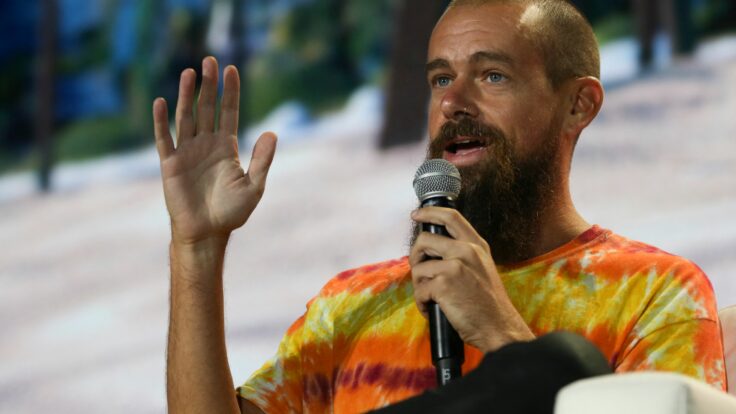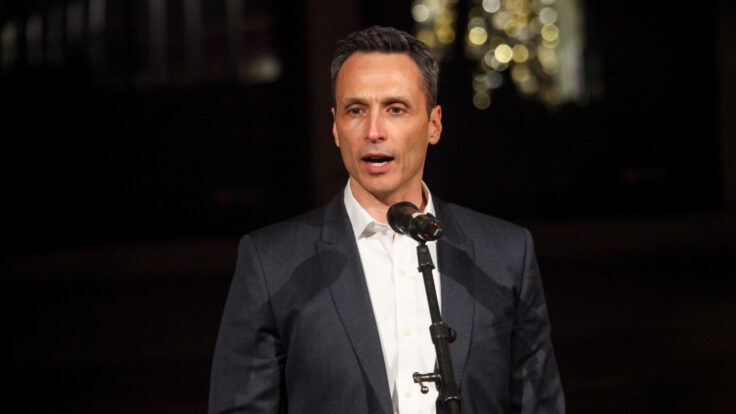 |
 |
|
Welcome back to what will likely be the least-opened, least-read edition of What I’m Hearing. I’m actually looking forward to all the bad news dumps on Election Day. Will CAA fire the agents on the alleged list that’s been floating around town? Warner Discovery’s gotta write down Joker 2 losses at some point, right? Is Tom Cruise finally replacing David Miscavige atop the Church of Scientology? Sure, go for it.
In honor of news dumps, tonight I’ve got a few odds and ends from my Notes app, then Scott Mendelson is back with analysis of Sony’s success with the Venom franchise and what it portends for post-Covid sequel budgeting…
Programming note: I’m in this Sky News mini-doc on Kamala Harris, talking about her and Doug Emhoff’s Hollywood connections. On The Town, Lucas Shaw and I parsed the chances of Comcast spinning off the NBCU cable networks, and Cinelytic C.E.O. Tobias Queisser explained how studios are using A.I. to help decide which movies to make. Subscribe here and here.
Click here to read the awesome report that got my colleague Tara Palmeri banned from Mar-a-Lago. Got a news tip? Reply to this email or message me privately on Signal at 310-804-3198.
Discussed in this issue: Shari Redstone, Vernon Sanders, Bob Iger, Clint Eastwood, Kevin Costner, John Paul DeJoria, Lawreen Loeser, Tom Hardy, Mike Cavanagh, David Ellison, Bob Bakish, Nick Pepper, Steven Spielberg, Tom Rothman, Jeff Shell, Jon Stewart, Jen Salke, Mariah Carey, and… SNL’s 80 wigs a week.
But first, an election edition of…
|
| Who Won the Week: Lachlan Murdoch |
|
| The Fox C.E.O. smashed earnings projections with “record political advertising across the company,” thanks to Fox News easily winning the election run-up over stagnant MSNBC and cratering CNN—even if the Yankees’ glorious meltdown in the World Series cost Fox nearly $100 million in revenue had the series gone two more games. |
|
|
“When it comes to criticizing other comedians, Jon in his unique position often chooses to close ranks the way cops do when a fellow officer is under investigation for impropriety.”
—Wyatt Cenac, the former Daily Show correspondent, criticizing Jon Stewart’s quasi-support for Trump rally speaker Tony Hinchcliffe after the Puerto Rico blowup.
Runner-up: “My lawyer got into the Rock & Roll Hall of Fame before me.”
—Mariah Carey, highlighting Allen Grubman’s ridiculous induction in 2022.
|
|
A MESSAGE FROM OUR SPONSOR
|

|
|
PERFORMANCE UNLEASHED
With a distinct sporting personality, the Range Rover Sport is a peerless performer.
EXPLORE
|
|
|
| Monday Thoughts (A Pre-Election Notebook Dump)… |
|
- Iger bets on political abstinence: Much has been written about how Donald Trump’s threats of retribution scared corporate America into relative silence this election season, but nowhere is that better evidenced than by Bob Iger at Disney. Iger and his wife, Willow Bay, normally reliable donors to and advocates for Democrats, donated to zero candidates this election cycle, per regulatory filings. That’s in contrast to 2020, when the Igers gave hundreds of thousands of dollars to elect Joe Biden, though Iger had stepped down as C.E.O. earlier that year. In 2016, Iger backed Hillary Clinton against Trump, and filings reveal he’s been a regular donor to Kamala Harris in her various California races. Abstinence may be the smart move, given Disney’s recent political imbroglios in Florida and over Kamala B.F.F. Dana Walden’s oversight of ABC. But if Harris wins, will she remember which C.E.O.s stood up for her despite the pressure, and which didn’t?
- The Shari-Skydance mating dance in detail: Paramount dropped its S-4 registration statement with the S.E.C. today, and while I’ve only had time to scan—it’s hundreds of pages; I pity the associates at Cravath and Simpson Thacher who slaved over this thing—at first glance, a few details of interest emerge:
–Shari Redstone and/or her son Tyler Korff have the opportunity to join the “New Paramount” board should they choose, subject to caveats (page 41). However, a source familiar with Shari’s thinking told me tonight that neither she nor Korff will elect to serve on the board. Ellison will be chairman and his president, Jeff Shell, will also be a board member, as expected.
-Skydance has agreed to indemnify National Amusements Inc., the Redstone family holding company, up to $200 million for lawsuits that result from the sale (page 269). If you remember, that was a late-stage sticking point in the deal negotiations because Paramount’s Class B shareholders, among others, have made noises about litigation.
-There’s a detailed and fascinating “Background of the Transaction” timeline of the deal talks (starting on page 93), evidencing just how many suitors emerged with varying scenarios for Paramount besides Skydance/RedBird Capital. Shari took a lot of shit for supposedly favoring the Ellisons from the outset, but the timeline shows NAI and the Paramount special committee ran a pretty detailed process, with multiple suitors coming and going. The Skydance group persisted as others emerged, engaged, were evaluated, sometimes jerked everyone around (cough Edgar Bronfman Jr. cough), and then fell away.
-NAI lawyers didn’t tell their counterparts at Paramount about the Skydance talks until December 8, the day after I first reported them here in What I’m Hearing. Gotta love that.
-Warner Bros. Discovery, referred to here as “Party A,” aggressively courted a merger deal with Paramount. We know C.E.O. David Zaslav met with Paramount’s then-leader Bob Bakish in late December and they continued to talk into January. But as late as April 11, Zaslav was still pressing the bankers that there was a “strategic merit to a business combination” as long as any deal would not include cash considerations. That eventually went nowhere.
-It wasn’t just Warner Discovery. On January 11, Bakish and either Brian Roberts, the C.E.O. of Comcast, or Mike Cavanagh, interim C.E.O. of its NBCUniversal division (they are both referred to here only as “Party B”), discussed a possible acquisition of Paramount or “a potential joint venture involving a combination of the companies’ streaming platforms.” We knew they discussed some deal, but the timeline makes it sound like the talks with Comcast/NBCU were more extensive than previously reported. In late January, for instance, Team Roberts proposed licensing Paramount+ content for a fee, and then in February they suggested a more extensive streaming joint venture as long as Comcast maintained control of the product.
-At the same time, the special committee was negotiating concurrently with Skydance/RedBird and the Apollo/Sony team, which, like others, didn’t totally fall away until the very end. Even after the revised Skydance deal was accepted, seven separate suitors—including the P.E. firm Apex and, yes, Bronfman—either proposed offers or inquired about how to top Skydance. But none eventually did.
- Clint’s final flex at the box office: As predicted last week, Clint Eastwood’s Juror No. 2 performed pretty damn well this weekend in only 30 or so theaters in 18 markets. Warner Bros. didn’t advertise the film, likely the last from the legendary 94-year-old director, and the studio didn’t report grosses, arguing that the well-reviewed legal drama was greenlit for Max and given a few dozen theaters essentially as a courtesy (pure awards-qualifying runs are typically much more limited). But despite that hurdle, IndieWire estimated that Juror grossed about $300,000 this weekend, or about $9,000 per theater. And my own source familiar with the numbers at AMC Theatres told me the film grossed $136,500 on 15 screens, or $9,100 per screen. (Warners declined to comment.)
If Juror were putting up those per-screen numbers in a platform release, its distributor would typically up the theater count and try to build a word-of-mouth hit. But Warners won’t, I’m told, choosing instead to hold the $35 million-budgeted title for Max (plus theatrical in a few overseas markets) and mount a modest awards campaign. Ironically, Sony just gave more than 2,600 screens and proper marketing to the wrong release, Robert Zemeckis’s Here, which flopped with critics and opened to just $4.8 million, or less than $2,000 per screen. Maybe Sony and Warners should have switched movies.
- Amazon’s post-election nail-biter: Amazon Prime Video, which seems to be in a constant state of reorganization, is bracing for a post-election “streamlining” in line with C.E.O. Andy Jassy’s companywide mandate to eliminate managers and “layers that create overhead and waste valuable time.” That will almost certainly include Prime Video’s byzantine television structure under Amazon MGM Studios head Jen Salke. Even the most aggressive agents still have trouble figuring out who has power under TV head Vernon Sanders. Nick Pepper, for instance, runs the Wholly Owned Television Creative Organization, which sounds like a Scientology front company and includes three separate development teams, a first-look/overall deals unit, and an I.P. research and scouting group. At the same time, Freevee, the company’s free, ad-supported service, will finally sunset, I’m told, an obvious move that I discussed earlier this year when Prime Video turned on ads for all subscribers who don’t pay to opt out. (A Prime Video rep declined to comment on the upcoming moves and referred me to a January statement about Freevee being “an important part of our offering on Prime Video.”)
- Oscar’s new “open season”: Ready for even-more-aggressive Oscar campaigns this year? Lawreen Loeser, the 24-year Academy veteran and rules enforcer for the awards committee and board of governors, was forced out by the organization’s recent return-to-office mandate. Loeser, despite living in the Midwest since Covid, helped prevent the most hyper-aggressive studios and streamers from overstepping guidelines, like in the infamous Andrea Riseborough Best Actress Situation of 2023. It’s now “open season” for boundary-pushing, two campaigners predicted to me, especially since the post-Riseborough rules tweaks include loopholes. But according to an email from Academy official Meredith Shea to campaigners, the enforcement “will not miss a beat.” We’ll see.
- Who wants a ‘Horizon’ documentary?: Kevin Costner’s four-part Western Horizon: An American Saga may have been left for dead after Part 1 flopped in theaters and Part 2 was pulled by Warner Bros., but incredibly, Costner’s WME team is shopping a Horizon behind-the-scenes documentary. Yes, it may be the height of self-importance that Costner believes a streamer would pay for an earnest chronicle of a notorious bomb. But Part 1 has done okay on Max, and while the HBO Documentaries team is aware of the project, they haven’t seen it yet, I’m told. So who knows, maybe this could become a cult classic of hubris and unintended irony. (WME declined to comment.)
|
| Now Scott looks at the B-level franchise success of ‘Venom’… |
 |
| Rise of the Reasonably Priced, Moderately Successful Blockbuster |
| As it turns out, avoiding monstrous budgets and not always swinging for the fences can be a solid way to make money on a mid-sized global hit like ‘Venom: The Last Dance’ or ‘Beetlejuice Beetlejuice’—with or without China’s occasionally significant (but far less reliable) returns. |
|
|
|
| After years of breathlessly attempting to greenlight all-quadrant megaprojects based on supersized I.P., a pivot appears to be afoot in Hollywood. As the movie industry recovers from years of tentpole production impacted by inflation, pandemic overruns, and strike delays, the town is taking stock of altered theatrical expectations and—in some cases—budgeting even the most seemingly surefire titles with comparative frugality. Sony Pictures, in particular, has been playing proverbial moneyball all year round, with mid-budget titles pulling solid but not spectacular global grosses—and the rest of the industry may not be far behind.
Thanks to a relatively thrifty $120 million budget, Sony’s recent Venom: The Last Dance, which returned Tom Hardy to the Spider-Man villain role for the third time since 2018, is still slated to be profitable despite much lower domestic returns. It has earned $317 million globally in less than two weeks, including $70 million from China, making it one of the few films this year where China accounted for more than 20 percent of the global gross, alongside Godzilla x Kong ($132 million out of $571 million) and Alien: Romulus (a surprising $110 million out of $350 million).
Even better for Sony’s frugally inclined movie chief Tom Rothman, none of the three Venom films needed the Chinese market to clear a profit. That includes Venom, which earned a now-implausible $269 million in China in 2018 (part of an $854 million global cume) and Venom: Let There Be Carnage, which did not get a Chinese release in 2021 and still grossed $508 million worldwide.
Instead, reasonable budgeting led to circumstances where a best-case scenario at the box office wasn’t needed to get into the black. Meanwhile, the past year has seen similarly budgeted tentpoles—like Sony’s Bad Boys: Ride or Die ($404 million worldwide on a $100 million budget) and Warner Bros.’ Wonka ($635 million globally on a $125 million budget)—delivered a higher rate of return. They could be examples of a new normal, where all but the largest tentpole franchises are budgeted at a level that does not require record-breaking—or even 2010s-level—box office.
|
|
|
| The Era of Belt-Tightening |
|
| Hollywood tends to obsess about studio overspending gone awry—Joker: Folie à Deux’s nearly $200 million budget is only the most recent example—but there are just as many instances of penny-pinching gone awry. Beyond just Paramount’s recent run of animated incarnations of its otherwise live-action I.P., like Teenage Mutant Ninja Turtles and Transformers, the aforementioned Godzilla x Kong was the cheapest (at $135 million) of the current run of Legendary and Warner Bros.’ MonsterVerse films. Likewise, at a cost of just $80 million (compared to $97 million for Alien: Covenant and $130 million for Prometheus), Alien: Romulus didn’t have to break out in China to qualify as a commercial win.
Amid Covid-impacted moviegoing and a decade-long shift to streaming, domestic and overseas totals should be assumed to be lower for everything that doesn’t become a Top Gun: Maverick or even a Longlegs breakout indie. With China now far less likely to juice the global totals of already successful films or bail out domestic underperformers (such as Pirates of the Caribbean: Dead Men Tell No Tales in 2017), relative frugality can allow for the kind of wiggle room that is effectively required in this less predictable ecosystem.
For instance, Warner Bros. was able to cut the budget for Beetlejuice Beetlejuice from $147 million to $100 million. So the film’s $293 million-and-counting domestic haul was already sufficient to cover over its softer $153 million overseas gross. In contrast, the $155 million spent on Twisters, a similar legacy sequel, meant that its underwhelming overseas earnings ($103 million) nearly overshadowed a $268 million domestic run.
Many pre-Covid franchises started and continued on heavily managed budgets. Most of Dwayne Johnson’s star vehicle successes (Rampage, Journey 2, San Andreas, the Jumanji sequels, etcetera) were budgeted in the $80 million–$130 million sweet spot. However, his over/under $200 million vehicles (Black Adam and Jungle Cruise) didn’t quite pan out. Sony learned its lesson with 2016’s $144 million-budgeted Ghostbusters: Answer the Call, which suffered from little appeal outside the U.S. Rothman spent only $75 million on 2021’s Ghostbusters: Afterlife.
Paramount’s Sonic the Hedgehog trilogy went from a $90 million-budgeted franchise starter in 2020 to a $110 million sequel in 2022 to an estimated $122 million threequel opening in December. So Sonic the Hedgehog 3 doesn’t have to even match its predecessor’s $405 million global gross to be a success. While Venom: The Last Dance opened with barely half of what the first two films in the series earned in their respective domestic debuts, it cost just $120 million, not significantly more than Venom’s $90 million and Venom 2’s $110 million. Hence, it’s already on the road to solid profitability.
Disney is still in the regular business of offering $200 million-plus Marvel films and animated sequels, and that still pays off (Inside Out 2 and Deadpool & Wolverine) at least as often as not (The Little Mermaid and The Marvels). However, time will tell if Disney will also pivot to lower budgets for animated originals and less-surefire MCU movies or live-action fantasies. Of course, “lower budget” could mean closer to Captain America: The Winter Soldier ($170 million in 2014) or Cinderella ($90 million in 2015).
Sequels have often been expected to cost more but gross less, which wasn’t as big of an issue when the $25 million Ghostbusters in 1984 would spawn a $40 million Ghostbusters II five years later. But the goal should be not to spend so much on the follow-up that a reasonably lower gross leads to actual monetary loss. We’ll see if the next batch of franchise-friendly I.P. titles will be budgeted closer to Uncharted ($120 million in 2022) than Star Trek Beyond ($185 million in 2016). Studios should still make sure that everyone involved gets paid and they offer relatively cinematic spectacle. However, give or take an Avatar or Avengers, a readjustment of expectations is in order after a decade in which $200 million blockbusters soaring past $1 billion worldwide became an almost semi-regular occurrence. Those days are over.
|
|
|
| If Comcast, which literally sells cable TV network packages, doesn’t want to own those cable TV networks, does anyone? [Bloomberg]
Hen Mazzig will help you craft a pro-Israel social media post that won’t get you canceled. [NY Times]
This “Streaming CPM Chart” shows how much Prime Video has tanked the value of ads across platforms: “Year over year, the average CPM for Netflix declined the most, down 32 percent from $54.78 to $37.02 during this year’s upfront.” [Ad Age]
John Paul DeJoria, the tequila and haircare billionaire who was part of producer Steven Paul’s bid for Paramount, now wants to take over CBS News and create a “middle of the road” outlet. Good luck prying it away from the Ellisons. [Sunday Times]
This chart of billionaire political donors puts Steven Spielberg’s net worth at $9.6 billion, a number I hadn’t seen before. If accurate, he’s definitely the richest pure talent in Hollywood history (meaning he doesn’t own his work, DreamWorks and its sale notwithstanding). [Bloomberg]
Sony has long resented CBS’s distribution rights for Jeopardy! and Wheel of Fortune, so this week’s lawsuit is no surprise. [LA Times]
Everything you’d ever want to know about Jodi Mancuso, the SNL wig department, and the 80 hairpieces they create each week. [Vogue]
|
|
|
| My discussion of California’s plan to boost film and TV incentives sparked a constructive email from a veteran film business executive…
“If California wants the tax credit to be competitive and reinvigorate production here, it needs to start by making it work better for low- to mid-budget indie producers. It could do that by doing the following:
- —Get the base rate for films under $25 million to at least 30 percent before uplifts.
—For films under $25 million, allow producers to elect to sell the credit to third parties or get a refund over three years, which will unlock the ability to finance the incentive in the commercial bank markets. Allow the sale to third parties to work like the Georgia system, where it can effectively be syndicated to many buyers.
—Qualify above-the-line spending, including writing steps that were paid within some reasonable period prior to qualification, subject to some per-person and percentage-of-budget caps.
—Create uplifts for hitting diversity, apprenticeship, and jobs-ratio targets.
—Qualify contingent compensation like the U.K. scheme does, to incentivize more producers and platforms to give it.
—Figure out some way so that qualification can happen anytime during the year instead of in set windows.
—Apply the above to television projects with gross budgets under like $6 million or $7 million per episode.
—Create chained uplifts for sequels and subsequent seasons. That means for each initial film or TV series that qualifies for the credit, an extra 2.5 percent for each sequel or season that shoots in California, up to some cap. If you don’t qualify for the credit in any subsequent season, the uplift chain breaks. That incentivizes platforms to re-up California projects, and for producers to keep them here.
—Lastly, they should consider introducing a postproduction and visual effects credit for projects that spend at least 80 percent of the post and/or VFX spend here. That part of the pipeline is the next to leave, especially once it’s impacted by A.I. Incentivize innovation and companies to be here instead of offshore.”
|
|
|
| We know Mufasa: The Lion King will be huge around Christmas, but look out for Robert Eggers’ Nosferatu as a potential indie sleeper, according to the latest early tracking chart from The Quorum… |
|
|
Have a great week,
Matt
Got a question, comment, complaint, or ideas for what to get Tom Rothman for his 70th birthday? Email me at Matt@puck.news or call/text me at 310-804-3198.
|
|
|
|
| FOUR STORIES WE’RE TALKING ABOUT |
 |
|
 |
|
 |
| Comcast’s Stunner |
| Assessing the viability of Comcast’s spinco concept. |
| WILLIAM D. COHAN |
|
 |
|
|
|
|
|
 |
|
|
|
Need help? Review our FAQs
page or contact
us for assistance. For brand partnerships, email ads@puck.news.
|
|
You received this email because you signed up to receive emails from Puck, or as part of your Puck account associated with . To stop receiving this newsletter and/or manage all your email preferences, click here.
|
|
Puck is published by Heat Media LLC. 227 W 17th St New York, NY 10011.
|
|
|
|




















